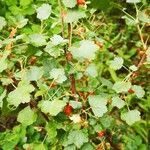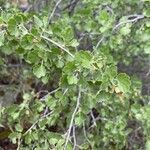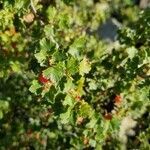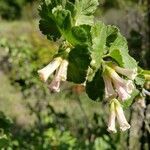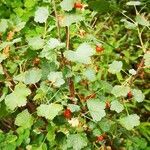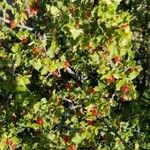Plants 0.2-2 m. Stems spreading or arching to erect, puberulent, sparsely to copiously stipitate-glandular; spines at nodes absent; prickles on internodes absent. Leaves: petiole (0.3-) 0.6-1.2(-2.8) cm, glabrous or finely to copiously pubescent; blade almost reniform to broadly cuneate-flabellate, 3-5(-7)-lobed, shallowly cleft, (0.5-) 1-2(-4) cm, base cordate to truncate, surfaces glabrous or copiously pubescent, sparsely stipitate-glandular to downy to conspicuously stipitate-glandular and sessile-glandular, particularly noticeable on margins, lobes rounded, margins coarsely crenate-dentate, apex obtuse. Inflorescences pendent, solitary flowers or 2-8(-9)-flowered racemes, 1-3 cm, axis finely pubescent, ± sticky with short-stalked to subsessile glands, flowers tightly clustered at end of peduncle. Pedicels jointed, (0.4-) 1-2.2(-3.4) mm, puberulent; bracts flabellate or ovate to obovate, 3-7(-8.8) mm, pubescent, stipitate-glandular. Flowers: hypanthium white to greenish white with pink tinge, or pinkish white, narrowly tubular, tube widest at base and near throat, 5-9(-9.4) mm, densely hairy and scattered stipitate-glandular abaxially, glabrous adaxially; sepals not overlapping, spreading-recurved, greenish white to white or faintly to strongly pinkish tinged, deltate-ovate, 1-3.2 mm; petals connivent, erect, white to pink, orbiculate or flabellate, not conspicuously revolute or inrolled, 1-2.1 mm; nectary disc not prominent; stamens shorter than petals, (inserted below petals and completely included in hypanthium tube); filaments linear, 0.5-1.6 mm, glabrous; anthers pale cream-yellow to yellow, oval, 0.6-1.2 mm, apex with small, cup-shaped gland; ovary glabrous or hairy or sparsely to densely pubescent; styles connate nearly to stigmas, 7.5-11.5 mm, proximally hairy or glabrous. Berries tasteless, dull to bright red or orange-red, ovoid, 5-12 mm, sparsely glandular to glandular. 2n = 16.
More
A shrub. It grows 0.9-1.8 m high and spreads 0.9 m wide. It has smooth stems. It loses its leaves during the year. The leaves are rounded or kidney shaped. They have 3-5 lobes. They are downy and have shallow teeth along the edge. The flowers are white or pale green and hang down. The fruit are shiny and red.
Canyons, dry ravines, hillsides, prairies and open woodland. Open forests, dry shrublands, rocky slopes, cliffs; at elevations from 100-4,000 metres.
More
It is a temperate plant. It grows on subalpine slopes and clearings in the Rocky Mountains. It suits hardiness zones 5-9.
